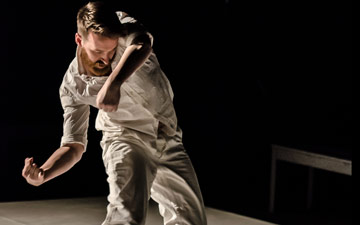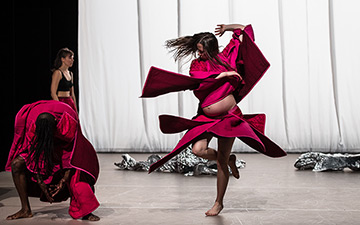
© Pari Naderi. (Click image for larger version)
Theo Clinkard
Accumulation, Ordinary Courage
London, Laban Theatre
28 January 2014
www.theoclinkard.com
www.trinitylaban.ac.uk
At just a few minutes long, the first piece of this double bill – Trisha Brown’s wonderfully wry Accumulation – is more of an amuse-bouche than main course. The bitty solo, performed by Theo Clinkard, nevertheless sates, its playful pedestrianism indulging where its length does not.
A deliberately simple premise steers Accumulation, long hailed as a pioneering slice of the postmodern dance movement: the lone performer builds up a single phrase in increments, accruing arm movements, hip swivels and weight transfers until the gradations together form a complete dance. The piece is not without its complexities, though their visibility tends to be contingent on a sufficiently nuanced performance. Fortunately Clinkard obliges: hints of fragility chip away at his robust comportment, and this vulnerability buoys his presence, animating the dark undertones of the deceptively sunny music (The Grateful Dead’s ‘Uncle John’s Band’) and bringing to the fore the increasingly disconsolate American consciousness Brown confronted when she created the piece in 1971.

© Pari Naderi. (Click image for larger version)
Ordinary Courage, the evening’s centrepiece and the company’s debut work, also grapples with despondency, though its approach is more explicit: here six dancers move through the stages of grief, collapsing in tandem under the weight of their demons and mapping the emotional junctures one must traverse to attain deliverance.
The dancers commence the piece with a multilateral tableau, intertwining their limbs and moving in silence until the opening notes of Scarlatti’s Sonata in D minor shatter their communion. From here denial takes hold, and they rush a rolling tide of ugliness, repeatedly charging against the invisible wave despite its indifference to their efforts, the sound of crashing water eventually swallowing the on-stage pianist’s stately chimes. The choreography veers between individual motions and group interactions; both are personal, organic, purposeful.
The dancers’ patent impotence gives rise to a surge of anger culminating in a violent fight between two of the men. Their helplessness swiftly returns, however, and the group succumbs to a fit of convulsions before seguing into an ode to depression. This segment is Ordinary Courage’s weakest: along with some predictable choreography – including a phrase in which the group props up one dancer disabled by her depression, manipulating her like a puppet – it contains a remarkably hollow, self-important scene featuring, inexplicably, a lumbering bear.

© Pari Naderi. (Click image for larger version)
Fortunately the rousing romp that is the final movement restores the calibre to previous levels. Energetic and uplifting, this portion marks the performers’ acceptance of their fate, their interaction shifting to effortless cooperation as they caper, colliding and reacting like buzzing atomic particles. The sound of water returns, this time in the form of gentle droplets that drive home the already obvious motif of renewal. The final steps – a reprise of the initial tableau, invigorated with music and energy – prove a neat conclusion, a swaddle that binds the piece snugly.
Like much of Clinkard’s work, Ordinary Courage refuses to be dainty; it throws its sweat at you and dares you to reject it. One of its biggest strengths is its marriage of the natural and the performative: the dancers’ limbs wilt and bloom in response to the core-centric movement vocabulary, their periodic limpness both intentional and reflexive. Whether they’re genuinely relaying the emotions at hand or merely affecting them is perhaps a question better put to the semiotics experts, but there’s no doubting the sincerity of their communication.

















You must be logged in to post a comment.